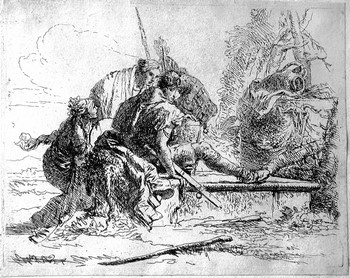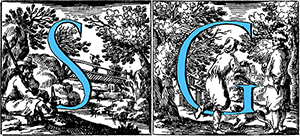
TIEPOLO Giambattista
(Venice 1696 – Madrid 1770)
Venetian painter and engraver, son of Domenico ‘merchant of ship shops’ and Orsetta Marangon.
His father Domenico died a year after the birth of his son, leaving the family in serious financial straits.
The first artistic training of Giambattista took place at the workshop of the painter Gregorio Lazzarini from whom he assimilated the grandiose and theatrical taste of the compositions.
In addition to his contemporary painters such as Giovanni Battista Piazzetta, Sebastiano Ricci and Federico Bencovich his study was also addressed to the Venetian masters of the 16th century from Tintoretto to Paolo Veronese and also to the work of Jacopo Bassano.
As early as 1717 he was registered in the guild of Venetian painters. In 1719 he married Cecilia Guardi, sister of the painters Gianantonio and Francesco, from whom he had nine children, including Giandomenico who will follow his father’s artistic activity.
Among the most important early paintings we can highlight the “Passage of the Red Sea” the “Glory of St. Teresa” the “Carmelites of Venice”, the “Madonna del Carmelo” now in Milan in the Pinacoteca di Brera, and the “Four mythological scenes” in the Gallerie dell’Accademia in Venice. His fresco activity was extraordinary, with grandiose works such as the decorations of Palazzo Sandi- Porto in Venice and those of the Palazzo Vescovile and the Cathedral of Udine. He produced cycles of decorative frescoes for important palaces in Milan and for the Colleoni Chapel in Bergamo. From 1737 to 1750, fresco decorations, altarpieces, canvases of mythological, historical and allegorical subjects followed one another without interruption, so that his creativity appeared inexhaustible.
His style, cleaned of every baroque heaviness, shows a lightened colour, which nevertheless retains strong tonal highlights with sharp and sudden deadlifts, to create fantastic scenographic spaces in which the depicted characters face are overbearing in the foreground or are sucked into the vast clarity of the backgrounds.
Between 1743 and 1745 in Venice he painted the ceilings of the Scuola del Carmine and the Chiesa degli Scalzi and the stories of Antonio and Cleopatra at Palazzo Labia. Still in 1743 he decorated Villa Cordellina near Vicenza. In 1750 he went to Wurzburg for the decoration of the dining room and the staircase of the residence of the prince-bishop Carlo Filippo von Greiffenklau with frescoes celebrating the exploits of Emperor Federico Barbarossa. Back to Italy, he frescoed Villa Valmarana in Vicenza together with his son Giandomenico, Villa Pisani in Stra, while in Venice he worked at Palazzo Ducale and for the decorative cycle in Palazzo Rezzonico. In 1761 Charles III of Spain called Tiepolo in Madrid to decorate the rooms of the new Palazzo Reale with frescoes. Also here Giambattista made several works until 1770 when he suddenly died.
Also in the field of etching he could express true graphic masterpieces. Today critics consider unanimously its engraving activity of the highest technical and artistic quality.
It includes the series of Capricci (ten tables) made in the late ‘30s of the 18th century and the jokes of Fantasia (twenty-three tables) that Giambattista realized between 1750 and 1755.
These works, rich in creative elements and fantastic imagination, appear engraved with extraordinary light effects. The graphic works of Giambattista are the best masterpieces of the artist, perhaps even more valid than his celebrated pictorial work. In his etchings there is a lesson borrowed from Rembrandt and strongly reworked in a Venetian key.



